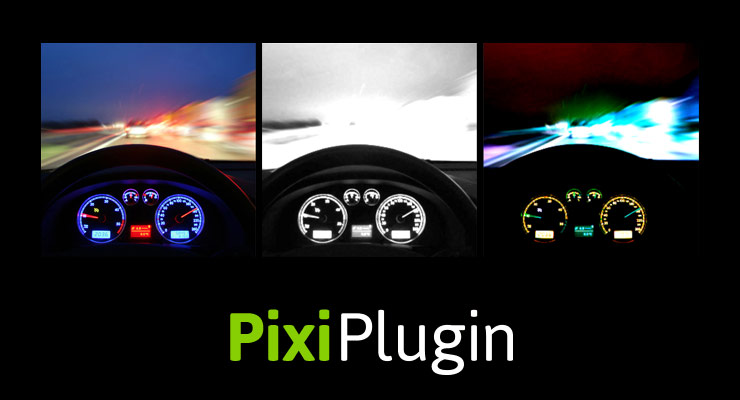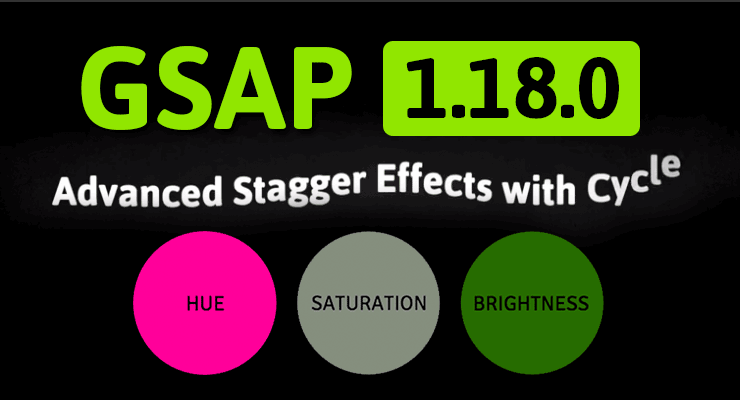Search the Community
Showing results for tags 'hue'.
-
PixiJS is a canvas library that can utilize WebGL for insanely fast rendering, plus it has all sorts of crazy filters and fun effects. You could always use GSAP to animate PixiJS objects (after all, GSAP can tween any property of any JS object), but it was a tad cumbersome with certain properties because they're tucked inside sub-objects in PixiJS's API, like object.position.x, object.scale.y, object.skew.x, etc. Plus PixiJS defines rotational values in radians instead of degrees which isn't as intuitive for most developers/designers. PixiPlugin saves you the headaches: //old way (without plugin): gsap.to(pixiObject.scale, {x: 2, y: 1.5}); gsap.to(pixiObject.skew, {x: 30 * Math.PI / 180}); gsap.to(pixiObject, {rotation: 60 * Math.PI / 180}); //new way (with plugin): gsap.to(pixiObject, {pixi:{scaleX: 2, scaleY: 1.5, skewX: 30, rotation: 60}}); PixiJS requires that you define color-related values in a format like 0xFF0000 but with PixiPlugin, you can define them the same way you would in CSS, like "red" | "#F00" | "#FF0000" | "rgb(255,0,0)" | "hsl(0, 100%, 50%)" | 0xFF0000. You can even do relative HSL values! "hsl(+=180, +=0%, +=0%)". Another big convenience is that PixiPlugin recognizes some special values like saturation, brightness, contrast, hue, and colorize (which all leverage a ColorMatrixFilter under the hood). Or if you have a custom ColorMatrixFilter, just pass that in as the colorMatrixFilter property and it'll handle animating between states. Lastly, PixiPlugin recognizes blur, blurX, and blurY properties, so it's very simple to apply a blur without having to create a new BlurFilter instance, add it to the filters array, and animate its properties separately. PixiPlugin significantly improves developer ergonomics for anyone animating in PixiJS. Less code, fewer headaches, and faster production. See the docs for details. To learn how to include PixiPlugin into your project, see the GSAP install docs.
-
Note: This page was created for GSAP version 2. We have since released GSAP 3 with many improvements. While it is backward compatible with most GSAP 2 features, some parts may need to be updated to work properly. Please see the GSAP 3 release notes for details. The latest version of GSAP delivers some fun new features that open up entirely new animation possibilities. Check out the videos and demos below that show what's so exciting about 1.18.0. Here's a quick summary: New "cycle" property allows you to add rich variations to staggered animations Relative HSL color tweens (affect just the hue, saturation or lightness) Complex string tweening like "1px 5px rgb(255,0,0)" Numerous improvements and bug fixes (see github) New "cycle" property for staggered animations Have you ever wanted to animate a bunch of elements/targets and alternate between certain values (or even randomize them) in a staggered fashion? The new super-flexible "cycle" property does exactly that. Instead of defining a single value (like x:100, rotation:90), you can define an Array of values to cycle through (like cycle:{x:[100,-100], rotation:[30,60,90]}) or even use function-based values (like cycle:{x:function() { return Math.random() * 200; }}). The amount of functionality you can pack into a single line of code is staggering (pun intended). Demo: array-based and function-based "cycle" values See the Pen Basic staggerTo() using cycle by GreenSock (@GreenSock) on CodePen. Advanced "cycle" effects with SplitText See the Pen SplitText with stagger and cycle by GreenSock (@GreenSock) on CodePen. Caveats The cycle property is available only in the staggerTo(), staggerFrom(), and staggerFromTo() methods in TweenMax, TimelineLite and TimelineMax. When using function-based values the function will be passed an argument which represents the index of the current tween. Inside the function body, the scope (this) refers to the target of the current tween (see source of first demo above). Relative HSL color animation Have you ever wanted to tween a color to something a little darker or lighter without having to guess at cryptic hex values? How about tween a hue to 180 degrees around the color wheel? With relative HSL tweening, it's easy. You can now use familiar relative prefixes ("+=" and "-=") directly inside hsl() strings! //30% darker backgroundColor:"hsl(+=0, +=0%, -=30%)" //to grayscale (0% saturation) backgroundColor:"hsl(+=0, 0%, +=0%)" //opposite color (180 degrees around the other side of the color wheel) backgroundColor:"hsl(+=180, +=0%, +=0%)" Relative HSL demo See the Pen Relative HSL color tweening in GSAP 1.18.0 by GreenSock (@GreenSock) on CodePen. Caveats Be careful about doing relative tweens when they could be interrupted. For example, if you have a mouseover that creates tween to +=30% and then a mouseout that does -=30% and then the user rolls over/out/over/out, you'll get odd results because of the nature of relativity. For bullet-proof rollover effects with relative values check out the demo we used in the video: Hover Demo with Relative HSL Values When you tween to a saturation of 0%, that basically loses any kind of hue data - the underlying color/hue of grayscale is non-existent. So then if you try tweening back to a saturation of 80% or something, it'll be red because that's the default zero position of hue. For example, tween a blue <div> to "hsl(+=0, 0%, +=0%)" and then to "hsl(+=0, 80%, +=0%)", it'll end up red instead of blue. That's not a bug - it's just the nature of colors in the browser (they end up in the rgb color space). Tween complex string-based values Complex string-based values containing multiple numbers can be animated without any extra plugins. For example, a value like "10px 20px 50px" can be animated to "4px 13px 200px". GSAP will find each number in the strings (in order), compare them and animate the ones that changed. CSSPlugin already does this for CSS values and it even converts units, but the base engine (TweenLite) can now do basic string tweening. It will even find rgba(...) values and make sure to round them appropriately during animation. This new feature extends to AttrPlugin too which means it can animate the complex strings inside SVG element attributes like the points in a <polygon> or <polyline> or even <path> data (please carefully read the caveats below). See the Pen Complex string-based tweening: simple shape morph by GreenSock (@GreenSock) on CodePen. Caveats This feature is NOT intended to perform complex shape morphing in SVG. It simply animates the numbers inside the strings (in order). Robust shape morphing requires dynamically parsing path data and injecting extra points in certain cases. This new complex string-based tweening lays the groundwork in the core to do a lot of advanced effects in the future, especially via plugins. If you're animating the "d" attribute of a <path> element or the "points" attribute of a <polygon> or <polyline> element, keep in mind that you MUST make sure the number (and type) of points match between the starting and ending values. And since those are attributes, use the AttrPlugin (which is already inside TweenMax). Community Demos City Construction by Sarah Drasner See the Pen City Construction Site by Sarah Drasner (@sdras) on CodePen. GreenSock Cycle by Petr Tichy See the Pen GreenSock - staggerTo with cycle by GreenSock (@GreenSock) on CodePen. Special Thanks This major update is extra special as it contains features that were largely shaped by feature requests and feedback from our community. We really appreciate the strong community that we have in our forums that not only helps each other, but also helps shape the tools themselves. Extra special thanks to Elliot Geno for suggesting cycle and relative HSL tweening, Diaco for being a testing powerhouse, and everyone who voted on the API changes. Now go download GSAP 1.18.0 and make something beautiful.
- 10 comments
-
- gsap
- javascript
- (and 13 more)
-
Hi. If I set the hue of a clear red square like this: var tl = new TimelineMax(); tl.to(this.square, 1, {easel:{hue:65}}) It turns brown(ish) If I create a #FF0000 square in Adobe Fireworks and set its hue to 65, it turns yellow. Do I miss something in the setting in the script? I think it's hard to find a doc of all settings for the easel. Thanks in advance John
-
Hi all. GSAP is a great framework, really enjoying using it. However I'm struggling to get Hue tweening using HSL within the Color plugin (via CSS automatic binding). A terse attempt to set a background box which tweens its color slowly through the color wheel is as below, but no change seems to happen. TweenMax.set(".wash",{backgroundColor:"hsl(0,50%,50%)"}); TweenMax.to(".wash",60,{backgroundColor:"hsl(+360_cw,50%,50%)",repeat:-1,yoyo:true,ease:Linear.easeNone}); If I remove the 'set' line, then there are some tweened changes to color, (visible in real time within Chrome when the element is selected) but they don't seem to visit the whole 360 degrees of the color wheel. Can anyone help tell me how this is meant to be specified or is a bug/missing feature with respect to degrees in HSL? For now I have the following kludge in place, but I don't like it much as I think something like the simpler syntax should work... TweenMax.set(".wash",{backgroundColor:"hsl(0,50%,50%)"}); var washTl = new TimelineLite(); washTl.to(".wash",10,{backgroundColor:"hsl(120,50%,50%)",ease:Linear.easeNone}); washTl.to(".wash",10,{backgroundColor:"hsl(240,50%,50%)",ease:Linear.easeNone}); washTl.to(".wash",10,{backgroundColor:"hsl(360,50%,50%)",ease:Linear.easeNone}); washTl.yoyo = true; washTl.repeat = -1; washTl.play();
-
I am using version 12.0, and I am wondering if this hue situation is a bug, or a limitation. I expect to take a solid colored object, adjust its hue around the 360 color wheel, and get a solid color back, but the colors I get are muddled. The saturation is off. I make a solid green object of 0x00FF00 (100% green). When I adjust the hue by 180, I expect it to go to the opposite side of the RGB color wheel to 100% purple, but it goes to 0xFF6EFF, or 255 for red and blue, as expected, but a green value of 110 (not 0), giving me a muddled purple. Similarly, when I try to adjust the same bright green object to bright red, using a hue adjustment of 240, it is a muddled red. I poked into the code, and see the use of Luminosity constants for R, G, and B at 0.212671, 0.715160, and 0.072169. Perhaps these are not the best constants? Perhaps the algorithm for hue adjustment on line 165 in ColorMatrixPlugin.as in version 12.0 is incorrect? var c:Number = Math.cos(n), s:Number = Math.sin(n), temp:Array = [(_lumR + (c * (1 - _lumR))) + (s * (-_lumR)), (_lumG + (c * (-_lumG))) + (s * (-_lumG)), (_lumB + (c * (-_lumB))) + (s * (1 - _lumB)), 0, 0, (_lumR + (c * (-_lumR))) + (s * 0.143), (_lumG + (c * (1 - _lumG))) + (s * 0.14), (_lumB + (c * (-_lumB))) + (s * -0.283), 0, 0, (_lumR + (c * (-_lumR))) + (s * (-(1 - _lumR))), (_lumG + (c * (-_lumG))) + (s * _lumG), (_lumB + (c * (1 - _lumB))) + (s * _lumB), 0, 0, 0, 0, 0, 1, 0, 0, 0, 0, 0, 1]; It is pretty complex, as I assume it needs to be, but could there be something askew in there? If I use a bright green object of 0x00FF00, and adjust the hue value by 60, 120, 180, 240, or 300; I was hoping I could get bright versions of teal, blue, purple, red, yellow. but it appears I can not get bright objects out of the hue transformation function. [in my attached image, I use two identical looking bright green circles, and adjust the right one to get bright red using code, but it does not come out as bright red. TweenMax.to(adjustedSprite, 1, {colorMatrixFilter:{hue:240 }} ); I remember reading about how Flash doesn't always work like Photoshop does, but this is just a color wheel hue issue, no? Thanks in advance, jimmi.
- 6 replies
-
- hue
- saturation
-
(and 2 more)
Tagged with:






